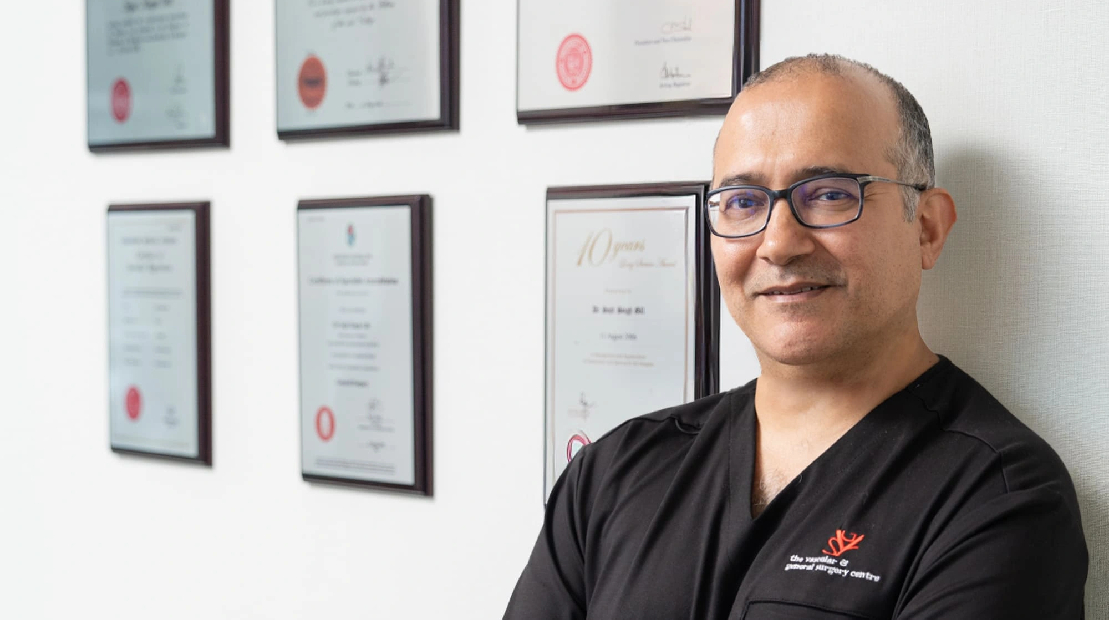Hernias affect millions worldwide. This common condition occurs when an organ or fatty tissue pushes through a weak spot in the surrounding muscle or connective tissue, often leading to a noticeable bulge. Recognising the different types of hernias, their signs, symptoms and treatment options is crucial for timely medical attention.
In this article, our vascular and general surgeon, Dr Sujit Singh Gill, explains the primary types of hernias in detail.
Types of Hernias
Hernias can occur in various parts of the body, but are most frequently found in the abdomen and groin. Knowing the specific type of hernia helps doctors recommend the most suitable treatment.
1. Inguinal Hernia
This is the most prevalent type of hernia, particularly common in men. It occurs when a portion of the intestine or fatty tissue protrudes through a weakened area in the lower abdominal wall, often extending into the inguinal canal located in the groin. While more frequently seen in males, women can also develop inguinal hernias.
Symptoms:
- Bulge or swelling in the groin, more obvious when standing, coughing or straining, and may disappear when lying down
- Pain or burning in the groin, especially during activities that increase abdominal pressure
- Heaviness, weakness or pressure in the groin
2. Femoral Hernia
Femoral hernias primarily affect women, especially older women, due to the wider bone structure of the female pelvis. They occur when tissue pushes through a weakened area in the lower abdominal wall and into the femoral canal. This canal is a narrow passageway located just below the groin crease, in the upper inner thigh, near the femoral artery and vein.
Symptoms:
- Lump or bulge in the upper thigh, just below the groin crease (sometimes in the groin itself)
- Pain or discomfort in the area, worse with standing, lifting or physical activity
3. Umbilical Hernia
An umbilical hernia occurs when fatty tissue or a section of the intestine protrudes through a weak spot in the abdominal wall, specifically around the belly button (navel). This type of hernia is particularly common in infants, often being present at birth. In adults, umbilical hernias are more likely to develop due to increased abdominal pressure from factors such as pregnancy and obesity.
Symptoms:
- Bulge at or around the belly button, more noticeable when coughing, crying, or straining
- Pain or discomfort around the navel, especially during activities that increase abdominal pressure
- Redness or tenderness around the bulge (indicates a potential emergency; seek immediate medical attention)
4. Hiatal Hernia
A hiatal hernia occurs when a portion of the stomach pushes upward through an opening in the diaphragm and into the chest cavity. This often happens due to a weakening or enlargement of the diaphragm's opening, known as the hiatus. Hiatal hernias are more common in individuals over 50, especially those who smoke and are obese.
Symptoms:
- Heartburn and acid reflux, with food or liquid regurgitation
- Difficulty swallowing (dysphagia)
- Chest pain or discomfort
5. Incisional Hernia
An incisional hernia occurs when abdominal tissue or an organ protrudes through a weak spot in the abdominal wall that resulted from a previous surgical incision. These can appear months or even years after the initial surgery.
Symptoms:
- Bulge or lump at or near an old surgical scar
- Pain or discomfort at the site, worse with movement, straining or heavy lifting
- A feeling of pressure, aching or heaviness in the abdomen
6. Epigastric Hernia
An epigastric hernia forms when fatty tissue, or sometimes part of the intestine, pushes through a weak spot in the abdominal muscles in the upper abdomen, specifically between the belly button and the breastbone. This creates a painful bulge in the midline. They are more common in men and individuals assigned male at birth, particularly those between 20 and 50 years old.
Symptoms:
- Small bulge in the upper abdomen
- Pain that worsens when coughing, straining or lifting
Diagnosis of Hernias
Diagnosing a hernia typically involves a combination of methods, with a hernia specialist or doctor determining the most appropriate approach:
- Physical Examination: First, the doctor will visually inspect and manually feel for a bulge in the suspected area and assess for tenderness or pain. For men, a digital rectal exam might be part of checking for inguinal hernias.
- Imaging Tests: While many hernias are diagnosed through a physical exam alone, imaging tests, such as ultrasound, CT scan, or MRI, may be used to confirm the diagnosis, determine the size and contents of the hernia, or rule out other conditions. These tests are particularly useful for smaller hernias, those that are not easily palpable or to assess for complications.
Treatment Options
Hernia treatment almost always requires surgical repair to prevent serious complications like incarceration (when tissue becomes trapped) or strangulation (when blood supply is cut off). Dr Gill customises treatment based on the hernia type, size, patient age, and overall health.
The main surgical methods are:
- Open Hernia Surgery: This is a traditional and effective method. A single incision is made over the hernia, the protruding tissue is repositioned, and the weakened wall is reinforced with stitches or mesh.
- Laparoscopic Hernia Surgery: This is a minimally invasive approach that uses several small incisions, a camera (laparoscope) and specialised instruments. The hernia is repaired, typically with mesh, from the inside. This generally leads to faster recovery, less pain and smaller scars.
Why Choose Dr Sujit Singh Gill
Dr Sujit Singh Gill is a highly experienced surgeon specialising in hernia repair, offering over two decades of expertise in both traditional and minimally invasive surgical techniques. He is committed to a patient-centric approach, ensuring every individual receives comprehensive care specifically tailored to their needs. Our clinic at The Vascular & General Surgery Centre also offers convenient and comfortable facilities designed to provide a reassuring environment throughout the entire treatment journey.




